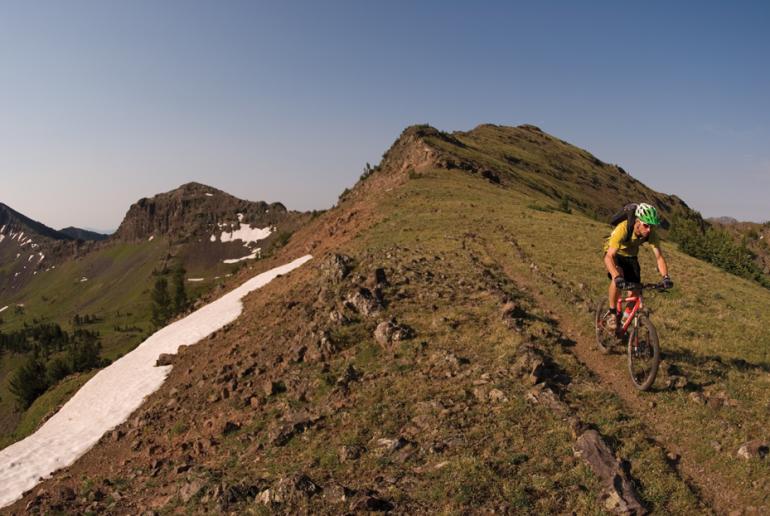Bike It Or Block It Off?
Like many political issues, the recent reduction in mountain-bike access to the core of the Hyalite–Porcupine–Buffalo Horn Wilderness Study Area (WSA) has received both lavish praise and intense criticism. The Forest Service’s contentious decision—a response to U.S. District Court Judge Donald Molloy’s ruling that the Gallatin National Forest’s 2006 Travel Plan did not adequately restore and protect the WSA’s wilderness character—cuts bike access by almost 65%. As part of an “interim management plan,” the ban is in effect indefinitely, pending further legal review or until Congress and user groups can find answers to the ongoing Wilderness question. Outside Bozeman asked bikers on both sides of the trail what they thought of the new restrictions.
Good Call
Stewart Mitchell
The Wilderness Recreation Partnership (WRP) was formed by mountain bikers with help from local enviros to promote a balance between wilderness protection and recreational opportunities. I helped form this group to protect core wilderness areas and promote the development of new bike trails.
Living in Bozeman means living on the edge of the most intact wilderness in the lower 48. Being in this lucky demographic gives us many world-class recreational opportunities. In less than an hour’s drive we can be hunting elk in pristine wilderness while keeping an eye out for griz. We can go ice or rock climbing. We can paddle the Gallatin in a raft, canoe, or kayak. We can hunt with a dog on a nearby ridge for blue grouse. We can load a backpack and march south for days, crossing few roads. We can fish for trout. We can hunt ducks. We can mountain bike deep into the backcountry without ever entering a Wilderness Area. We can go backcountry skiing or snowmobiling. We can ride a motorcycle from the Bangtails to the Tobacco Roots, hardly ever on pavement.
Most of these opportunities exist because wilderness exists. And protecting the core of the WSA will not diminish the quality of any of the above activities.
WRP believes that in return for enjoying all the local landscape has to offer, we have a duty to protect what little true wilderness is left. We also recognize that we need to get together and develop new trails for the increasing demand of all users. By giving up a little, we gain much. There might not be many people riding on the Gallatin Crest now, but if the current trend plays out, 50 years forward there will no longer be wilderness in the Gallatin Range.
Stewart Mitchell is a contractor, reigning master’s Cat 2 national downhill mountain bike champion, and chief executive of the Wilderness and Recreation Partnership’s Attitudinal Affairs department. Join WRP at gallatinwrp.org.
Bad Idea
Bob Allen
The landscape within the WSA is important for the pristine beauty, wildlife habitat, watersheds, and primitive backcountry recreation. Passion runs deep on all sides of the history and future of the 155,000 acres known broadly as the Gallatin Crest. Sadly, this spectacular WSA has languished undecided and unprotected for 33 years too long.
Judge Molloy made it clear in his ruling last September that neither the Forest Service nor the court system can resolve the conundrum we continue to face over this WSA. The contentious lawsuit-driven management plan just released by the Gallatin National Forest is an ill-fitting band-aid for this now-gaping WSA wound. Only Congress can fix what was started in 1977—and the only way that a Montana elected official will EVER touch another Wilderness bill is by having it settled and packaged by a grassroots, community-supported process.
Unless Judge Molloy’s ruling is overturned in the appeal filed by the Forest Service, the WSA will be managed into the distant future by litigation rather than the effort and goodwill of the people. If we as the greater community are serious about protecting this unique piece of public ground and replacing the WSA with a permanent Congressional designation, it will require an earnest collaboration. And if the Wilderness-or-nothing dialog has failed us for 33 years, isn’t it time to try something new?
Society, political realities, and the land-protection debate have evolved over the past three decades. There are more viable tools in the Congressional toolbox than a Wilderness designation alone. Support from the quiet, non-motorized bicycling community will be key to passing any legislative protection including new, bike-banning Wilderness. Let’s get this important conversation started—this is our collective challenge, and legacy.
Bob Allen is an outdoor photographer, bicycle evangelist, and founding board member of the Montana Mountain Bike Alliance. Find out more at montanamountainbikealliance.com.














